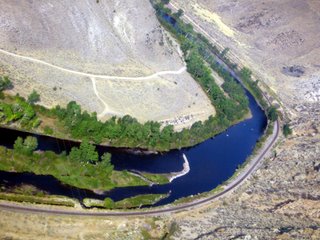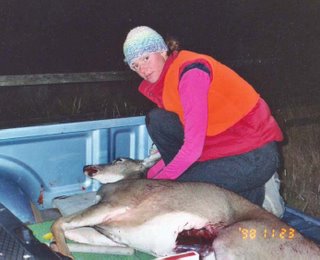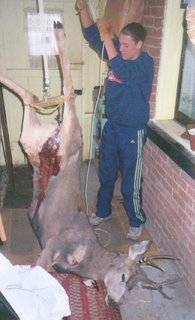Today, I sat in on the meeting of the Mile High Conservation District Meeting (Butte). Last week, the Beaverhead County Conservation District met in Dillon (I did not attend this meeting, and am relying primarily on notes from Mike Bias). Per Montana law, the Conservation Districts ruled on the alleged violations of the state’s Streambed Preservation Act. We should note that Butte conservationists George Grant and Tony Schoonen (both intimately connected with the founding of the Big Hole Foundation and our local Trout Unlimited chapter) helped create the Streambed Preservation Act in 1975. This law is enforced through local Conservation District committees. To do work in the streambed, an irrigator must first obtain a 310 Permit.
There were five alleged violations of the Streambed Preservation Act. They were made known to the Conservation District by individuals who filed the “Official Complaint Form 274.” The five included one large diversion dam built near the downstream end of Maiden Rock; two near the Meriwether Ranch access bridge above Melrose; one near the turn off to the Twin Bridges road just below Melrose; and one near the Burma Road by the public bridges at the turn-off from Glen to Notchbottom.
These diversion dams were large structures built primarily of gravel pushed up by operating heavy equipment in the river bed. Several included large trees and in some cases the trees were anchored into the bank. In at least one case, the diversion dam was impassable to boats. In all cases, the large dams were intended to divert more water into irrigation ditches.
It is important to note here that the legality of the dams themselves is the point in question. No one is questioning the alleged violators’ water rights, or whether the alleged violators are taking an amount of water exceeding their legal right.
The Conservation Districts ruled that in four of the five complaints, a violation had indeed occurred. When a Conservation District deems that a violation has occurred, it may require the violator to fix the problem and may fine the violator up to $500 for the initial violation, and up to $500 per day for an ongoing violation.
Although the Beaverhead County district agreed that the dam near the Burma Road had been “built too big—too high and wide, and with an added wing dam” not specified in the original 310 Permit, this structure was ruled “no violation” because it could be covered by a maintenance permit previously granted to the irrigator.
The Mile High district found that the Maiden Rock dam was built with an excessive amount of material that very likely violated the 25 cubic yard limit imposed by DEQ. To move more material than this, the irrigator is supposed to apply for a 318 Permit. No such permit was applied for. Despite the apparent violation, it seems that no action will be required of this irrigator—primarily because the dam was not extended in length beyond its historic endpoint. It was not at all clear how or why a violation of the 318 Permit should be overlooked, although as in the other dams cited in the complaints, this one was constructed by “a new contractor unfamiliar with the rules.”
Both Districts agreed that the two dams near the Meriwether Bridge were clear violations. Both dams were constructed by the same irrigator. The primary violations lay in blocking river travel (i.e. in extending a dam clear across the river channel) and in anchoring large trees into the bank to enhance the dam. The violator was notified to reduce the structure in accordance with their 310 Permit. To date, however, only one tree has been removed because the irrigator cannot get to the other one with the equipment that he has. “High water will take care of the other one,” according to the Mile High district. The violator had been asked to reduce the size of their structure well before the 274 Complaints were filed, but refused to do so. But once the complaints were received and the violator was notified by the Conservation Districts, he became contrite and so no fine will be levied.
The Beaverhead district ruled that the irrigator violated their 310 Permit in constructing the dam below Melrose. The permit specified that it was to be a wing dam extending ¼ of the width of the channel, but the dam had been built nearly the full width of the river. Also, the irrigator had illegally installed a tree into the diversion structure. Furthermore, the irrigator’s permit has been expired for 16 years. Because boats could still pass by this diversion, it was not seen as a serious problem. The violator will be ordered to reduce the size of the diversion and to remove the tree. No fine will be levied.
Prominent in both Conservation District meetings was a reprimand by the chair of those who had made the alleged violations a public issue by talking with newspaper reporters and writing editorial pieces. The committee chairs were seriously pissed about this because as a public issue “It makes agriculture look bad.” It seems hard for the agricultural community to fathom why such violations are a public issue. The State of Montana, however, manages the waters and fish as a Public Trust. This Public Trust is of great interest to thousands of anglers, hunters, and other outdoor recreationists. When we see large diversion dams that block travel on the river and harm the streambed and aquatic life, the conservationist public is upset. After all, it is the public’s natural resources that are being damaged.
The Conservation Districts would like aggrieved anglers, outfitters, and conservation groups to find ways to fund improved diversion structure rather than resorting to the hammer of law. It seems that there are several potential sources of funding – including Montana FWP, Big Hole Watershed Committee, and DNRC monies – and it is up to the complainants to help raise the needed funds. The idea is that if irrigators had lots of money to construct efficient diversion structures, then they would not need to resort to “emergency” actions that violate their 310 Permit. Efficient diversion structures include permanent dams, concrete road barriers, and large metal plates. Both the concrete barriers and metal plates must be installed and removed on a seasonal basis.
Two other options are available to anglers, outfitters, and conservation groups that would like to reduce 310 Permit violations that damage public resources.
The first option is to amend the Streambed Preservation Act. When the law was passed, the conservation community had to make many concessions. The Conservation Districts were given wide discretion in interpreting the nature of violations and the penalties for violations. Individual irrigators were given a loophole for “emergency actions” that “safeguard life or property, including growing crops.” A tighter law with less leeway and fewer loopholes would be more protective of the Public Trust. The best strategy here would be to work with a lawyer to draft the language for the amendment, and then to lobby local legislators to carry and support the bill.
The second option is to reinstate DNRC’s decision that the Big Hole River is chronically dewatered. As you will recall, this is the action (along with the pending ESA listing for grayling) that brought the Big Hole Watershed Committee into existence in 1995. Because the watershed committee has not dealt with irrigation problems on the lower and middle river, this situation led to the spasm of 310 Permit violations this year. Several agency personnel I have talked with are fed up with the low flows on the lower Big Hole River, and encourage reviving the “Chronically Dewatered” designation. Among other things, this would force irrigators to install measuring devices on their head gates. As explained to me by a state agency person, the DNRC has prepared for adjudication by calculating how much water irrigators actually need based on their crop acreage. Often times, irrigators take and use far more water than their crops need or can effectively use. In one case, an irrigator with an 8 cfs diversion and a 5 cfs water right reduced his usage to 1.4 cfs. I am having an ongoing conversation with some state agency folks, and can let you know more about this option in a few days.
The next step is up to the George Grant Chapter of Trout Unlimited and the Big Hole Foundation. Some conservation goals require conservationists to lead and not merely be led.


 [photo at left: diversion dam near Maiden Rock; note that the irrigation ditch is in the LOWER left portion of the photo, and the river channel is in the UPPER left portion of the photo.]
[photo at left: diversion dam near Maiden Rock; note that the irrigation ditch is in the LOWER left portion of the photo, and the river channel is in the UPPER left portion of the photo.] Photo: A mouse came to the end of its road, taken by a small hawk.
Photo: A mouse came to the end of its road, taken by a small hawk. set of wolf tracks that ran through a low pass.
set of wolf tracks that ran through a low pass.
 I've become a hunting mentor to a young lad or two or recently completed their hunter safetey course, have a strong desire to hunt, but do not have parents or family that hunt. [The photos here are of my daughter Emily.]
I've become a hunting mentor to a young lad or two or recently completed their hunter safetey course, have a strong desire to hunt, but do not have parents or family that hunt. [The photos here are of my daughter Emily.]


